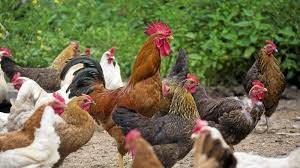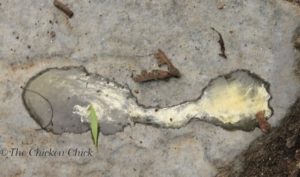•

• Or Salmonellosis (Pullorum, Bacillary white diarrhoea)
Post no-1340 Dt 28/07/2019
(Compiled & shared by-DR RAJESH KUMAR SINGH, JAMSHEDPUR, JHARKHAND, INDIA, 9431309542, rajeshsinghvet@gmail.com)
Introduction
Diarrhea in poultry is one of the commonly noticed sickness or disease in any poultry farm globally. They are also common to backyard birds rearing in rural areas in India..
This problem is very common & pose a little challenge to the farmer or poultry keeper.Daily we get calls from poultry farmers regarding white diarrhea in their birds.This problem becomes havoc in winter season.Most of the mortality among backyard poultry takes place due to this problem.In biological term it is nothing but Pullorum Disease or Bacillary White Diarrhea,It is also also called Salmonellosis
Pullorum disease (PD), also referred to as bacillary white diarrhea, is an acute septicemic disease affecting primarily chickens and turkeys. It is caused by the Salmonella enterica subsp. enterica Gallinarum-Pullorum bacterium. It is one of several different diseases that are collectively referred to as Salmonellosis. PD rarely occurs in commercial poultry anymore, however it is quite common in backyard flocks.
• Disease caused by one of the two poultry-adapted strains of Salmonella bacteria, Salmonella Pullorum, this usually only causes mortality in birds up to 3 weeks of age. Occasionally it can cause losses in adult birds, usually brown-shell egg layers. It affects chickens most commonly, but also infects turkeys, game birds, guinea fowls, sparrows, parrots, ring doves, ostriches and peafowl. It still occurs worldwide in non-commercial poultry but is now rare in most commercial systems.
Morbidity is 10-80%; mortality is increased in stressed or immunocompromised flocks and may be up to 100%. The route of infection is oral or via the navel/yolk. Transmission may be transovarian or horizontal mainly in young birds and may sometimes be associated with cannibalism. The bacterium is fairly resistant to normal climate, surviving months but is susceptible to normal disinfectants.
Classification
OIE, List B disease
Signs:
• Inappetance.
• Depression.
• Ruffled feathers.
• Closed eyes.
• Loud chirping.
• White diarrhoea.
• Vent pasting.
• Gasping.
• Lameness.
• Peracute infection with sudden death,
• Acute infection in first few days:
o Weakness,
o Somnolence,
o Anorexia,
o Poor growth,
o Pasting of vent with chalky white excreta,
o Death.
• In older birds:
o Lethargy,
o Huddling under brooders,
o Wing droop,
o Dyspnoea.
Growth retardation and poor feathering of survivors.
Post-mortem findings :
Gross lesions may be seen in chronic disease, but are usually absent in peracute disease. When present the following may be seen:
• Enlargement and congestion of liver, spleen and kidneys,
• Yolk sac retention, with yolk appearing creamy or caseous,.
• Lung and heart may have white nodules, pericardium may be thickened, with yellow or fibrinous exudate,
• Gastro-intestinal tract – may have white nodules on the gizzard, caeca, large intestinal wall.
• Caseous cores may be seen in the caeca.
• Joints may be swollen with yellow viscous fluid.
Grey nodules in lungs, liver, gizzard wall and heart.
• Intestinal or caecal inflammation.
• Splenomegaly.
• Urate crystals in ureters.
Diagnosis———–
Isolation and identification. In clinical cases direct plating on Brilliant Green, McConkey and non-selective agar is advisable. Enrichment procedures usually rely on selenite broth followed by plating on selective media.
Differentiate from Typhoid, Paratyphoid, paracolon, other enterobacteria, chilling and omphalitis
Differential diagnosis:
• Fowl typhoid,
• Fowl cholera,
• Erysipelas
Transmission ———
From infected birds, their faeces and their eggs. Ingestion of contaminated food, water or bedding, and contact transmission; also mechanical spread by humans, wild birds, mammals, flies, and on trucks, feed sacks. May occur in newly-hatched birds due to trans-ovarial transmission.
Risk of introduction:
Pullorum could be introduced by importation of live infected chicken, hatching eggs. The bacteria can also be found in poultry meat but contamination of poultry flocks through this route is at low risk.
Control / vaccines:
Live and inactivated vaccines are available for fowl typhoid in some countries.
If introduced control should focus on eradication of the disease through isolation and destruction of contaminated flocks, proper disposal of carcasses and disinfection of fomites.
Treatment:
Sulphadiazine, Sulphamerazine, sulphapyrazine, Sulphamethazine are the most effective in chicken (not in turkey poults). Furazolidone is effective. Also chloramphenicol, colistin and apromycin are effective. No vaccination practised and all positive birds may be disposed off by slaughter. Birds recently vaccinated with S. gallinarum (9R) may give low titre. Since Tran ovarian transmission of organism is there, only eggs from salmonella free flock should be used for hatching. No treatment is likely to effect complete elimination of carrier from infected birds
Amoxycillin, poteniated sulponamide, tetracylines, fluoroquinolones
Homeopathy For chicks with white foamy diarrhea administer Calc carb + Cala phos, and for adult birds with greenish brown diarrhea administer Sulphur and Ipecac .
Always disinfect incubator and all associated equipment prior to use Minimize exposure to environments contaminated by rodent or wild bird feces. Practice good insect control Properly dispose of any dead animal carcasses, do not allow birds contact with dead or decaying animals.
Prevention———–
Eradication from breeder flocks. As with other salmonellae, recovered birds are resistant to the effects of infection but may remain carriers. Vaccines are not normally used as they interfere with serological testing and elimination of carriers.
Prevention focuses on a clean and comfortable environment:
• Check feed for mold spores
• Provide fresh, clean water
• Keep the pen dry
• Check for vent prolapse – blowouts can result in diarrhea
• Add two tablespoons of vinegar to a gallon of water for drinking
• Try a probiotic such as yogurt
There are a number of simple steps you can take:
• Feed your birds a commercial, good quality pellet.
• Ensure feed is fresh, dry and in date and suitable for species and age of bird.
• Supply fresh drinking water in clean drinkers.
• Try to get rid of puddles in the range as these often contain lots of harmful bacteria and for some reason birds like to drink from them rather than their drinkers
• Regularly clean and disinfect your poultry coop using a detergent followed by an approved disinfectant such as korsolin th, vircon-s etc.
• Always worm your birds with –Albendazole/fenbendazole etc at least every three to four months.
• Give —Probiotics powder— every four to six weeks to top up the good bacteria in your birds gut
• Give your bird —anti toxin /—-livertonic syrup-on regular interval in its feed, this contains Biomos to absorb fungal toxins, mannanoligosaccharides to bind to harmful bacteria therefore stopping the harmful bacteria binding to the gut and chelated minerals allowing them to be more readily absorbed
WET /LOOSE DROPPINGS(DIARRHEA) IN LAYERS.——
Loose droppings in poultry are not a strange or a new phenomena. This usually occurs in various conditions such as,
High salinity in drinking water or high salt content in the fish
High fiber or molasses content in the feeding stuff and
Enteritis.
The above situations can be tackled by setting right the causative factor or administer a suitable anti-diarrhoeal agent.
There is one more “Loose Droppings” phenomena particularly in “young layers” with high production.
There is no apparent reason for this loose droppings and even the salt, fiber adjustment or using of anti-biotics or chemotherapeutic does not give any desired results.
The reason being that this is a physiological diarrhea.
When the production is high the oviduct jerks backwards pushing the formed egg towards the cloeca for laying.
Since the alimentary canal is situated just beneath the oviduct the rate of peristaltic moments are increased resulting intestinal “Hurry” and loose watery faecal matter resulting in loose droppings.
This watery droppings phenomena when continued for long the farm becomes a breeding centre for number of bacterial and parasitic infections with formation of Ammonia gas, worms, maggots and obnoxious stink.
The entire farm will be under a bad sanitary condition with poor bio-scrutiny rendering the birds more suspectable for diseases and other stress conditions including opacity of the cornea due to ammonia liberation.
Various compounds that work on the 10th cranial nerve were tried including Atropine and Belladonna alkaloids.
The results with alkaloids were good but with serious side effects.
Due to the inhibition of the “Vagus” the digestion got disturbed as sufficient enzymes were not liberated.
Further due to the dilation on egg laying, some other compounds inhibited the peristalysis and also movements of the uterus as they are working on the smooth muscles of the internal organs effecting the laying and also recorded shall less eggs.
Screening of old compounds resulted in finding out Pot.
Phenolanamide, which is only an intestinal sedative that reduces the peristaltic moments with out disturbing the endogenous liberation of digestive enzymes or dilation of the pupils disturbing the photoperiodism and the Hormonal secretion (FSH & LSH) and stimulation.
There was no other adverse effect on Liver, Kidney, Lungs, Heart or Production to the best of our knowledge and no other side effects, ill effects or after effects.
Wet droppings in cages can lead to fly menace besides poor feed efficiency.
There are diseases like E.Coli, Pasturella, Salmonella causing entertitis resulting in diarrhoea. These specific diseases can be treated with appropriate medication.
Sometimes wet droppings are seen in healthy flocks also. The physique of the flock undergoes a dramatic change during this period. The body weight goes up from 1350 to 1600gms. (A gain of 300gms). The feed consumption goes up from 80gms to 115gms. The water consumption goes up proportionately. There is a dramatic change in the feed quality from low mineral diet to high mineral diet. The day length is increased and there is 90+ productions. All these changes happen with in 6weeks.
The digestive system gets disturbed some times resulting in loose droppings.
The corrective measures are
Check feed for high fiber, high calcium, in feed. High salt and high nitrates in water.
Check for size of calcium grit.
Check gut motility by using products like Halquinol.
Use Enzymes which digest fiber and Phosphorus.
Use probiotics well in advance to keep the harmful bacteria at low level.
Check for specific diseases and treat.
Check the water nipples for high pressure or leaks which can increases the wetness from out side


